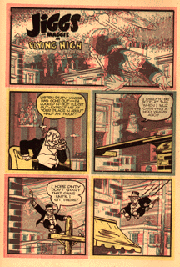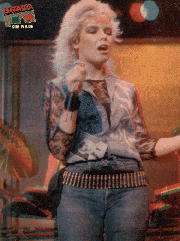
In September 1953 the first two-color anaglyphic comic book appeared with Three Dimension Comics, featuring Mighty Mouse. Artists Joe Kubert and Norman Maurer devised a means of producing cartoon art on several layers of clear acetate that would allow for lateral shifting to produce left and right eye views. They had unknowingly replicated and thereby infringed on a previous patent that had been granted to Freeman H. Owens in 1936 that was titled Method of Drawing and Photographing Stereoscopic Pictures in Relief. Though Three Dimension Comics was the first anaglyphic application, cartoon art had been rendered into stereographic form with the Tru-Vue strips of the 1930s.
As well, the anaglyph had long been used prior to 3-D comics for rendering line art stereoscopically. Arthur W. Judge, in his 1926 book Stereoscopic Photography, Its Application to Science, Industry and Education, noted the existence of an anaglyph book by M. H. Vuibert titled Les Anaglyphes Geometriques which made very useful application in connection with the stereoscopic representation of geometrical figures, crystal formations and other complicated three-dimensional figures. At the same time, however, Judge discouraged the use of color anaglyph: Anaglyphs can only be shown in monochrome, whereas stereograms (as in stereophotography) lend themselves in many cases to colour reproduction. For this reason line anaglyphs are not quite satisfactory, as a rule. The process of making anaglyphs is more complicated, and liable to errors, than that of obtaining stereograms...

Of the more than fifty anaglyph comic books that were published in 1953 and 1954 all were of the two-color variety. Two books, however, were published by Harvey Comics in January 1954 which, while not full polychromatic anaglyph, were interesting attempts to use the 4-color printing process in conjunction with the conventional two-color anaglyph. The comics were Jiggs and Maggie and Katzenjammer Kids. A page from Jiggs and Maggie demonstrates, in addition to the use of yellow as a graphic element, the placement of a black outline figure within the two-color anaglyph scheme.
Two-color anaglyph photos and art appeared sporadically throughout the 1950s and 1960s in a variety of magazines. With the April 1974 issue of American Cinematographer, however, a demonstrable breakthrough for polychromatic anaglyphs occurred with printed photographic images that demonstrated the Video WEST stereo process with a technique of spectorally separating the two color fields by means of a special module located within the camera objective lens. The color fringing of red and blue with these full color images is minimal and the result is a highly compatible 2-D/3-D image. The special module is applicable to motion picture cameras as well as still photographic cameras and it essentially uses a stereo base that is only as wide as the objective lens itself.
Surprisingly, the Video WEST system found no real widespread application in the motion picture field. But by 1982, the North Hollywood 3D VIDEO Corporation had begun selling color anaglyph conversions of 1950s 3D movies to the syndicated television market as well as millions of the requisite red/blue glasses. The 3D VIDEO process was a patented system that utilized Red, Green and Blue light primaries (or RGB) of the additive filtration color process and created a unique matrix for the left and right eye images embedded in the RGB scheme. Despite the difficulties of color matching with broadcast television and composite video which uses no clearly discreet separation of RGB colors, 3D VIDEO was successful in broadcasting such films as Gorilla At Large in polychromatic anaglyph.

The interest that the 3D VIDEO broadcasts generated in color anaglyph led to its use in European magazines such as Paris Match , and various other publications such as Bravo, a British teenage fanzine. Stereographers such as David Burder in England and Steve Aubrey in America created successful polychromatic anaglyphs using photographic techniques that multiplexed the original stereo pair of photographs into a single, final composite. Their work found publication in magazines and advertisements. The 3-D Zone company in America also created polychromatic anaglyphs for advertising and publishing using graphic color separation techniques as well as manipulation of a 4-color matrix to create a color 3-D conversion.
